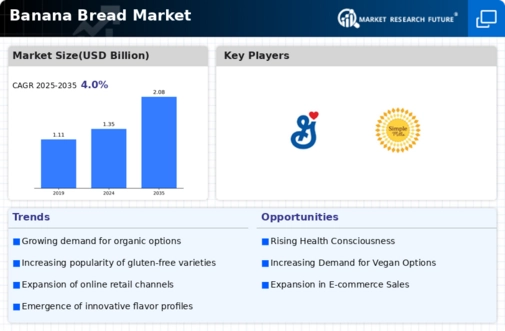Banana Bread Size
Banana Bread Market Growth Projections and Opportunities
The banana bread market is shaped by various market factors that influence its growth and dynamics. One of the primary factors driving this market is consumer preference and trends. Banana bread has gained popularity as a comfort food and a versatile snack option, appealing to consumers seeking convenient and indulgent baked goods. As consumer tastes evolve, there is a demand for innovative variations of banana bread, such as gluten-free or vegan options, as well as unique flavor combinations like chocolate chip banana bread or walnut banana bread.
Economic factors also play a significant role in shaping the banana bread market. Fluctuations in disposable income levels impact consumers' purchasing power and their willingness to spend on bakery products like banana bread. During economic downturns, consumers may opt for homemade banana bread instead of purchasing pre-packaged options, seeking more cost-effective alternatives. Conversely, during periods of economic prosperity, consumers may indulge in premium banana bread offerings, including artisanal or gourmet variations, driving sales in this market segment.
Regulatory policies and standards are another crucial factor influencing the banana bread market. Compliance with food safety regulations, labeling requirements, and ingredient standards is essential for manufacturers to ensure consumer trust and meet legal obligations. Additionally, certifications such as organic or non-GMO may influence purchasing decisions, particularly among health-conscious consumers seeking cleaner and more sustainable options.
Technological advancements also impact the banana bread market, particularly in food processing and packaging technologies. Improved manufacturing processes, such as automated mixing and baking systems, can enhance efficiency and consistency in banana bread production. Advanced packaging solutions, such as resealable pouches or portion-controlled packaging, can improve product freshness and convenience, meeting consumer expectations for quality and usability.
Competitive dynamics and market competition are significant factors in shaping the banana bread market. Established brands with strong brand recognition and distribution networks may dominate shelf space and consumer mindshare, posing challenges for new entrants. However, innovative startups and niche players can disrupt the market with unique offerings, such as specialty flavors or healthier ingredient alternatives, catering to specific consumer segments and driving innovation in the market.
Changing consumer lifestyles and dietary preferences also influence the banana bread market. The growing demand for healthier options, such as whole grain or low-sugar banana bread, reflects shifting consumer attitudes towards wellness and nutrition. Additionally, lifestyle trends such as on-the-go snacking or increased home baking during lockdowns have impacted consumption patterns and product preferences in this market.
Moreover, external factors such as weather conditions and agricultural trends can affect banana availability and pricing, impacting the supply chain and production costs for banana bread manufacturers. Variations in banana harvests or import/export regulations may lead to fluctuations in banana bread prices and availability, influencing consumer purchasing decisions and market demand.







Leave a Comment